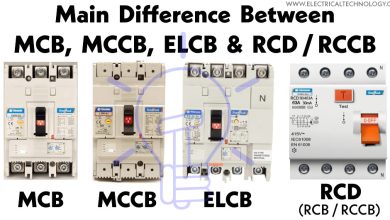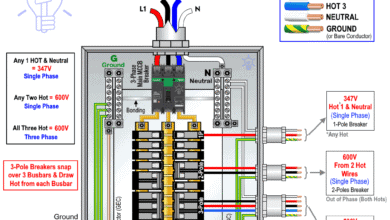Difference Between Voltage Stabilizer and Voltage Regulator (AVR)
Difference Between Automatic Voltage Regulator (AVR) and Voltage Stabilizer
Both voltage stabilizers and voltage regulators are used to control voltage levels. Voltage stabilizer is more focused on maintaining a stable output voltage within a specified range. On the other hand, voltage regulator (AVR) is designed to provide a constant output voltage regardless of input voltage variations.
The terms “voltage stabilizer” and “voltage regulator” are often used interchangeably. This article provides a general overview of the differences between voltage stabilizers and voltage regulators. The specific characteristics and performance of each device may vary depending on the design and application requirements.
What is a Voltage Stabilizer?
A voltage stabilizer is an electrical device designed to provide a stable voltage output to electrical equipment by automatically adjusting for variations in input voltage. It ensures that the voltage supplied to devices remains within a specified range. It is capable to protect them from damage caused by voltage fluctuations.
Voltage Regulator is a device or circuit which is designed to deliver constant voltage to the output without in changes in incoming voltage.
Voltage stabilizers are commonly used in homes, offices, and industries to maintain a stable voltage supply. They are used especially in areas where the mains voltage is inconsistent or prone to fluctuations.
- Related Post: Difference Between Online UPS and Offline UPS
What is a Voltage Regulator?
A voltage regulator is an electrical device or circuit that maintains a constant voltage level. It can be used to regulate the output voltage of a power supply or to control the voltage levels in electronic circuits. Voltage regulators are essential in ensuring that electronic devices receive a stable and consistent voltage. These requirements are critical for their proper operation and longevity especially in sensitive circuits and equipment.
Voltage Regulator is a device or circuit which is designed to deliver constant voltage to the output without in changes in load current.
Automatic Voltage regulators (AVR) are available in various forms based on solid-state devices, including integrated circuits (ICs), microprocessors, discrete components, and modules. They are used in a wide range of applications, from small electronic devices to large power systems.
Related Post: Difference between Voltage Source Inverter & Current Source Inverter
Comparison Between Voltage Stabilizer and AVR
Here’s a comparison table between voltage stabilizers and voltage regulators:
| Feature | Voltage Stabilizer | Voltage Regulator |
| Definition | It is a device which is designed to deliver constant voltage to the output without in changes in incoming voltage. | It is a device which is designed to deliver constant voltage to the output without in changes in load current. |
| Function | Maintains stable output voltage despite fluctuations | Maintains constant output voltage regardless of input |
| Response Time | Slower | Faster |
| Input Voltage | Handles fluctuations in input voltage | Assumes input voltage is stable |
| Output Voltage | Within a specified range | Constant |
| Accuracy | The accuracy level of AVR is ±1.5% to ±4% for the most developed voltage regulators. They are capable of withstanding hundreds of times the nominal running currents during inrush periods. | The accuracy level of servo-based stabilizers is ±1% to ±0.5%. While this might seem beneficial, most electrical equipment is designed to operate within a range of the nominal voltage ±10%. Therefore, AVR is still the winner. |
| Noise | Considerable noise due to (motors in servo type) and transformers | Negligible Noise due to solid state devices |
| Complexity | Typically simpler design | Can be more complex, especially for precise regulation |
| Maintenance | Regular maintenance is needed because of moving parts such as transformers and servo motors (in older technologies). | Since it contains solid-state components and microprocessors, it requires almost no maintenance because there are no moving parts. |
| Technology | The old-school servo motorized technology is outdated, and there have been no major developments or innovations in the past 20 to 30 years. | The AVR utilizes state-of-the-art technology, employing the latest microprocessor control and fastest switching technology. |
| Cost | Generally less expensive | Can be more expensive, depending on the application |
| Applications | Commonly used in areas with unstable mains voltage commonly for home and office uses | Used in electronic circuits, power supplies, and more especially in sensitive devices and components |
Related Posts:
- Difference between Photodiode and Photoresistor (LDR)
- Difference Between Photodiode and Phototransistor
Differences Between Automatic Voltage Regulators and Voltage Stabilizers
While both AVR and a stabilizer perform the same function, which is to stabilize the voltage, but there are some technical differences between the two:
Function:
-
- A voltage stabilizer is primarily designed to provide a stable output voltage despite fluctuations in the input voltage. It maintains the output voltage within a specified range, typically by using tap changers or electronic circuits to adjust the output voltage.
- A voltage regulator is designed to maintain a constant output voltage regardless of variations in the input voltage or load conditions. It regulates the output voltage by continuously adjusting the amount of voltage supplied to the load.
Response Time:
-
- Voltage stabilizers generally have a slower response time compared to voltage regulators. They are designed to handle gradual changes in input voltage and may not be suitable for applications requiring rapid voltage regulation.
- Voltage regulators typically have a faster response time, making them suitable for applications where quick and precise voltage regulation is necessary. For example, sensitive electronic circuits.
Applications:
-
- Voltage stabilizers are commonly used in situations where the input voltage is unstable or prone to fluctuations, such as in homes, offices, and industries.
- Voltage regulators are used in a wide range of applications, including power supplies for electronic devices, automotive systems, industrial equipment, and sensitive devices and applications.
Related Posts:
- Difference Between D-MOSFET and E-MOSFET
- Difference Between DIAC and TRIAC
- Difference between LED and Photodiode
- Difference Between LED and LDR
- Difference Between Phototransistor and Photoresistor (LDR)
- Difference Between JFET and MOSFET
- Difference Between BJT and FET Transistors
- Difference Between Diode and SCR (Thyristor)
- Difference Between Transistor & Thyristor (SCR)
- Difference Between Diode and Transistor
- Difference Between NPN and PNP Transistor
- Difference Between Encoder and Decoder
- Difference Between Microprocessor and Microcontroller
- Difference Between RAM and ROM – Comparison
- Difference Between CPU and GPU – Comparison
- Difference Between Multiplexer (MUX) & Demultiplexer (DEMUX)
- Difference Between Digital Latch and Flip-Flop Circuits
- Difference Between Combinational and Sequential Logic Circuits
- Difference between Zener Diode and Avalanche Diode
- Difference Between Inverting and Non-Inverting Amplifier
- Difference Between Amplifier and Operational Amplifier
- Difference Between Voltage Source and Current Source
- Difference Between Fast Recovery Diode and Step Recovery Diode
- Difference Between Schottky Diode and Fast Recovery Diode







